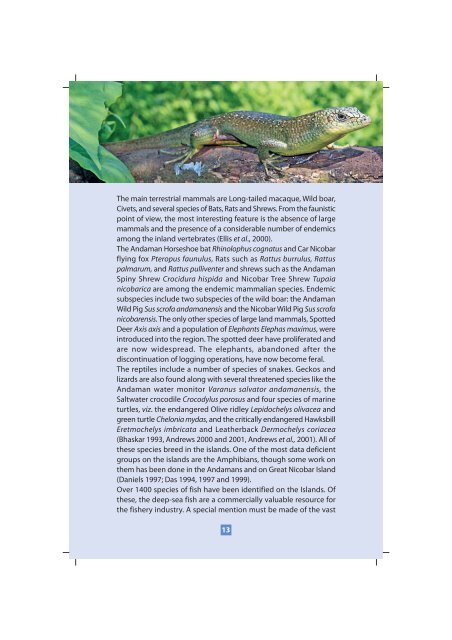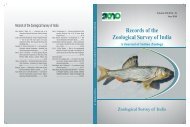Andaman booklet aw.FH10 - Zoological Survey of India
Andaman booklet aw.FH10 - Zoological Survey of India
Andaman booklet aw.FH10 - Zoological Survey of India
Create successful ePaper yourself
Turn your PDF publications into a flip-book with our unique Google optimized e-Paper software.
The main terrestrial mammals are Long-tailed macaque, Wild boar,<br />
Civets, and several species <strong>of</strong> Bats, Rats and Shrews. From the faunistic<br />
point <strong>of</strong> view, the most interesting feature is the absence <strong>of</strong> large<br />
mammals and the presence <strong>of</strong> a considerable number <strong>of</strong> endemics<br />
among the inland vertebrates (Ellis et al., 2000).<br />
The <strong>Andaman</strong> Horseshoe bat Rhinolophus cognatus and Car Nicobar<br />
flying fox Pteropus faunulus, Rats such as Rattus burrulus, Rattus<br />
palmarum, and Rattus pulliventer and shrews such as the <strong>Andaman</strong><br />
Spiny Shrew Crocidura hispida and Nicobar Tree Shrew Tupaia<br />
nicobarica are among the endemic mammalian species. Endemic<br />
subspecies include two subspecies <strong>of</strong> the wild boar: the <strong>Andaman</strong><br />
Wild Pig Sus scr<strong>of</strong>a andamanensis and the Nicobar Wild Pig Sus scr<strong>of</strong>a<br />
nicobarensis. The only other species <strong>of</strong> large land mammals, Spotted<br />
Deer Axis axis and a population <strong>of</strong> Elephants Elephas maximus, were<br />
introduced into the region. The spotted deer have proliferated and<br />
are now widespread. The elephants, abandoned after the<br />
discontinuation <strong>of</strong> logging operations, have now become feral.<br />
The reptiles include a number <strong>of</strong> species <strong>of</strong> snakes. Geckos and<br />
lizards are also found along with several threatened species like the<br />
<strong>Andaman</strong> water monitor Varanus salvator andamanensis, the<br />
Saltwater crocodile Crocodylus porosus and four species <strong>of</strong> marine<br />
turtles, viz. the endangered Olive ridley Lepidochelys olivacea and<br />
green turtle Chelonia mydas, and the critically endangered H<strong>aw</strong>ksbill<br />
Eretmochelys imbricata and Leatherback Dermochelys coriacea<br />
(Bhaskar 1993, Andrews 2000 and 2001, Andrews et al., 2001). All <strong>of</strong><br />
these species breed in the islands. One <strong>of</strong> the most data deficient<br />
groups on the islands are the Amphibians, though some work on<br />
them has been done in the <strong>Andaman</strong>s and on Great Nicobar Island<br />
(Daniels 1997; Das 1994, 1997 and 1999).<br />
Over 1400 species <strong>of</strong> fish have been identified on the Islands. Of<br />
these, the deep-sea fish are a commercially valuable resource for<br />
the fishery industry. A special mention must be made <strong>of</strong> the vast<br />
13
















